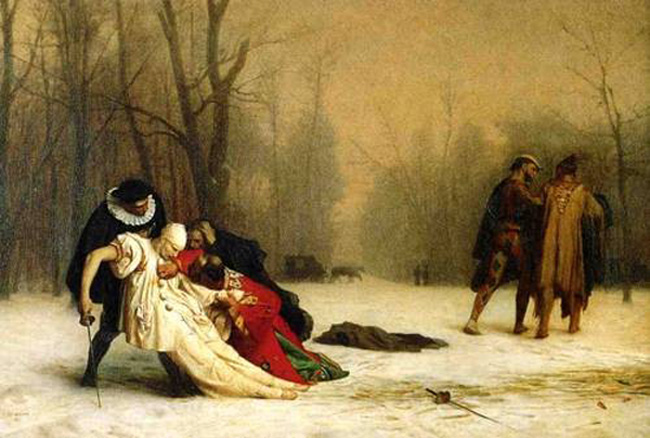Robert Nye,“The Culture of the Sword: Manliness and Fencing in the Third Republic” from Masculinity and Male Codes of Honor in Modern France
Masculinity and the Revival of Dueling in France
Gerome, Duel After the Masked Ball (1857)
Throughout their history, fencing and the duel have been tied inextricably together. From the late sixteenth through the seventeenth centuries, any good-sized town had a fencing hall owned and staffed by a master of arms and his apprentices. The master was subject to the rules of the Royal Academy of Arms, which governed the activities of the halls in the manner of all guilds. The academy was abolished with all other corporate monopolies in 1790, and by 1840 the number of halls in France had shrunk to about ten. 50 The art was kept alive during this period, for the most part, by retired regimental prevots whose students were themselves ex-officers or bored gentlemen-about-town.
Near the end of the Second Empire, to the delight of amateurs of the art, demand grew sufficiently to allow a modest increase in the number of masters to perhaps 35 "professors." A phenomenal expansion took place a few years after the Franco-Prussian war. By 1890 there were more than 100 masters-at-arms in Paris alone, and salles d'armes had sprouted in virtually every provincial city. Bordeaux's halls attracted 250 fencers, and Lyon and Marseille were not far behind. Nancy, Bourges, ClermontFerrand, Toulouse, and other towns of their size had at least two fencing venues. 51 In 1882 a Societe de I'encouragement de I'escrime ["Society for the Encouragement of Fencing"] was founded for serious Parisian amateurs; by 1889 it had well over 400 dues-paying members, an office, and an official publication. 52
In 1886 a group of Parisian masters reconstituted the Academy of Arms. They hoped to raise the standards of the art, but also, it was alleged, to limit competition for students in the capital by excluding newcomers to the trade. The academy also functioned as a mutual aid society for aged members. From 1878 the Parisian masters held an annual assault to replenish their retirement fund. 53 This event was a grand succes d'estime because it attracted an "elegant and mondaine crowd, clubmen, and noted fencers," and because it was the only assault at which most Parisian masters went head-to-head, watched eagerly by their prevots and students. 54
Many of the new department stores and a score of Parisian newspapers, such as Le Figaro, Le Gaulois, and La France maintained fencing halls and masters to keep their male personnel in working and fighting trim. 55 Beginning in 1882 the Societe de I'encouragement sponsored an annual fencing assault in the lobby of the Grand Hotel in Paris, featuring some of the best masters and socially prominent amateurs of the capital. This assault, like that of the Academy of Arms, was held in the midst of the Paris winter social season, attracting men and women in evening dress who were, by one account, the "flower of the fencing world, of sport, of Parisian elegance." 56
The republican nature of the art was emphasized by regular Sunday The republican nature of the art was emphasized by regular Sunday morning assaults originally organized at the Elysee palace by President Grevy's son-in-law, Daniel Wilson. These assaults, which continued through the term of Felix Faure, who was an enthusiastic amateur, were timed to coincide with the traditional hour of the Sunday mass and to attract the cream of the republic's judicial and administrative elite. 57 The private assaults of banquet societies such as the Societe du Contre de Quarte were more exclusive, giving themselves the "luxury of capriciously blackballing new applicants like the most chic cercles." 5 * The fencing press carried reviews of all these affairs in copious detail. In short, as one commentator put it in 1886, fencing is now the "official mode" of the "cultivated" set. 59
A typical assault of the 1880s entailed consecutive single combats between men of roughly equal skill. Dress was optional, but most men wore standard fencing hall gear and were fitted with a padded vest (plastron) and fencing gloves. The sharp tips of the foils were padded (mouchetes). The names of fencers were announced by a "herald-at arms," and organizers built drama into the proceedings by arranging the last few matches between well-known professionals or between two men known to dislike one another, not a difficult matter in these competitive and prickly milieux. Before every match, each man would bow elaborately to his opponent, sweeping his sword laterally in imitation of the nourish of a courtier's plumed hat. More gallant still, the professional Lucien Merignac invented an opening gesture in which he lunged toward his opponent in the classic attack position, but inclined the point of his foil backward along his arm and shoulder, symbolizing his wish to engage in combat but do no harm. The presence of women at these affairs presented further opportunities for ritual acts of courtesy. At an assault at the Ecole de Guerre in 1889, young ladies were each presented a flower by the officers participating in the match.
